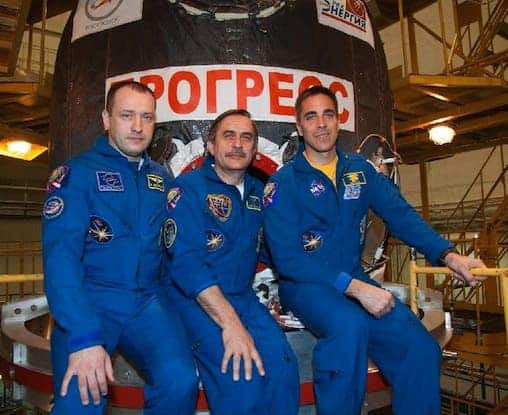
This afternoon a Soyuz spacecraft carrying three astronauts (two Russian and one American) is set for launch out of the Baikonur Cosmodrome in Kazakhstan, destined for the International Space Station, at 4:43 p.m. The flight is set to be a historical one, as it will set a new milestone in space launches. Typically, all manned flights up until now, be them through the now retired space shuttle or the presently tasked Soyuz, had taken at least two days to dock with the ISS. Today’s flight is set to dock with the space station in a mere six hours after launch.
Following three test flights with unpiloted Russian cargo spacecrafts, the astronaut team, comprised of NASA astronaut Chris Cassidy, along with Pavel Vinogradov and Alexander Misurkin of the Russian Federal Space Agency, will use the new ultra-fast docking technique riding in the Soyuz orbiter. For the past 13 years since manned crews have been ferried in and out of the ISS, such procedures took at least two days to perform. The accelerated schedule, however, means that today the astronauts will reach the space station in only four orbits of Earth.
“The four-orbit rendezvous has the advantage of a very short period of time from launch to docking,” Mike Suffredini, NASA’s International Space Station program manager, said of the mission. “It reduces the amount of time the crew has to spend in a small environment before they get to ISS.”
The astronauts will be joining commander Chris Hadfield and Flight Engineers Tom Marshburn and Roman Romanenko, who already are living on the station, and will be on space station for the duration of six months. During this time, they’ll be performing scientific experiments, space station upkeep, oversee robotic and unmanned courier and delivery services, and possibly the American crew, will conduct six spacewalks during their mission for space station maintenance.
“It’s a very fun and very interesting activity for us,” Misurkin said of spacewalking. “During these tasks we are doing to install some scientific equipment outside of the station, and also we are going to prepare some special stuff for the Russian module which will come a little bit later.”
You can check out the launch live via the NASA’s stream embedded right below.
UPDATE: The six-hour trip lasted roughly as long as an airplane flight from Seattle to Miami. It wasn’t without its nail-biting moments though (when is a space launch ever without any issues?), since at one point while approaching docking with the ISS, the Soyuz’s flight commander was a bit tenser than usual. “Hey, is anyone home?” Vinogradov joked. The new arrivals received a round of hugs and congratulations, exchanged warm words with loved ones back on Earth via the station’s communication link, and finally settled down for rest at the end of a long, long day.
Was this helpful?



